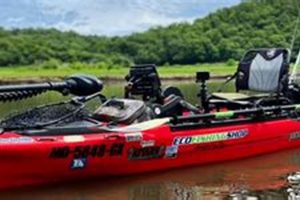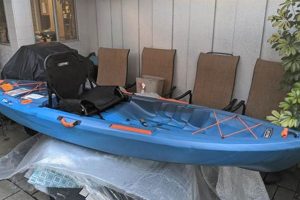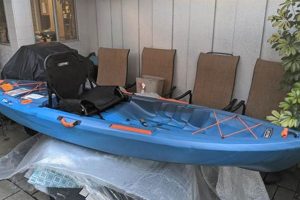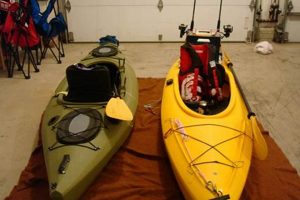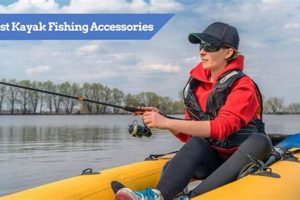Equipment designed to enhance the angling experience from a kayak encompasses a range of items. These include mounting systems for transducers and displays, power solutions like batteries and wiring, and protective cases. Dedicated transducers optimized for kayak use and specialized wiring harnesses for streamlined installation also fall under this category. For instance, a RAM mount secures a fish finder to the kayak, while a portable battery powers the device, and a transducer arm positions the sonar below the waterline.
Such enhancements provide significant advantages for kayak anglers. Improved fish detection, more precise navigation, and a safer experience on the water are key benefits. Historically, kayak fishing relied heavily on angler intuition and knowledge of local waters. Modern technology, however, allows for targeted fishing, reducing search time and increasing catch rates. This also contributes to conservation efforts by minimizing the disruption of non-target species and habitats.
The following sections will explore specific equipment categories in detail, offering guidance on selection, installation, and optimal use to maximize angling success from a kayak. Topics covered include transducer selection and mounting, power management solutions, and the integration of GPS and chartplotting functionalities.
Tips for Optimizing Electronic Enhancements for Kayak Fishing
Strategic selection and deployment of electronic enhancements significantly improve angling success from a kayak. The following tips provide guidance for maximizing the benefits of these tools.
Tip 1: Transducer Selection and Placement: Opt for transducers specifically designed for kayak use, considering factors such as hull material and fishing style. Proper placement, often achieved with specialized mounting arms, minimizes interference and optimizes sonar readings.
Tip 2: Power Management: Portable, rechargeable batteries offer flexibility and eliminate the need for complex wiring. Calculate power requirements based on anticipated usage and select a battery with ample capacity.
Tip 3: Cable Management and Security: Securely route cables to prevent tangling and interference with paddling. Utilize cable ties and clips to maintain a clean and organized setup.
Tip 4: Display Mounting and Visibility: Choose a mounting system that provides stable, adjustable display positioning. Consider glare and viewing angles for optimal readability in varying light conditions.
Tip 5: GPS and Chartplotter Integration: Integrating GPS and chartplotting capabilities enhances navigation and allows for marking productive fishing spots. Ensure compatibility between chosen devices.
Tip 6: Weatherproofing and Protection: Protect electronic devices from water and impact damage with waterproof cases and covers. Consider mounting locations that minimize exposure to the elements.
Tip 7: Regular Maintenance: Regularly inspect and clean all components. Check battery health and ensure software updates are installed to maintain optimal performance.
By implementing these tips, anglers can leverage the full potential of electronic enhancements, leading to increased fishing success and a more enjoyable experience on the water.
These practical strategies pave the way for a more informed and productive approach to kayak angling, underscoring the vital role of technology in modern fishing practices.
1. Transducers
Transducers serve as the core sensory component within kayak fish finder accessory systems. They transmit and receive sonar signals, translating these into visual representations of underwater structures and fish. The choice of transducer directly impacts the quality and accuracy of the data displayed on the fish finder. Factors such as frequency, cone angle, and power output influence performance characteristics. For instance, higher frequencies provide detailed images in shallower depths, while lower frequencies penetrate deeper but offer less detail. A wider cone angle covers a larger area, while a narrower cone angle provides a more focused view. Understanding these characteristics is crucial for selecting the appropriate transducer for specific fishing environments and target species.
Practical considerations for transducer installation on kayaks necessitate specialized mounting solutions. These often involve adjustable arms or brackets designed to accommodate the kayak’s hull shape and minimize interference. Correct placement and alignment of the transducer are essential for accurate readings and preventing signal distortion. Improper installation can lead to inaccurate depth readings, poor target identification, and interference from turbulence or cavitation. Therefore, understanding the interplay between transducer selection, mounting hardware, and kayak characteristics is paramount for optimizing fish finder performance.
Ultimately, transducer selection and integration represent a critical aspect of optimizing kayak fish finder accessories. Choosing the right transducer for the intended fishing application and ensuring proper installation significantly impacts the system’s effectiveness. This understanding empowers anglers to make informed decisions and maximize their chances of success on the water.
2. Mounting Systems
Mounting systems represent a critical link between kayak structure and fish finder functionality. They provide the secure and stable platform necessary for transducers, displays, and other related accessories. Effective mounting systems must withstand the rigors of the kayak fishing environment, including vibration, water exposure, and occasional impacts. Stability is paramount, as a poorly mounted transducer can generate inaccurate readings due to excessive movement or incorrect alignment. Furthermore, a secure display mount ensures clear visibility and accessibility without obstructing paddling or other essential kayak operations. For instance, a robust, adjustable arm secures a transducer to the kayak’s hull, minimizing turbulence-induced interference, while a RAM mount system provides a stable and adjustable platform for the fish finder display.
Several mounting options cater to different kayak configurations and angler preferences. Track-based systems offer flexibility in positioning accessories along pre-installed tracks, while clamp-based mounts attach directly to the kayak’s gunwales or other structural elements. Adhesive mounts provide a low-profile solution for certain accessories. Each mounting system presents unique advantages and limitations. Track systems offer versatility but may require specialized hardware. Clamp systems are generally easy to install but may not be suitable for all kayak designs. Adhesive mounts provide a clean aesthetic but can be challenging to remove or reposition. The selection of an appropriate mounting system depends on the specific kayak, the accessories being mounted, and individual angler preferences. Considering factors such as stability, adjustability, and ease of installation ensures optimal fish finder performance and overall user experience.
Optimal mounting system selection enhances fish finder performance and contributes significantly to a streamlined and efficient kayak fishing setup. Careful consideration of kayak compatibility, accessory requirements, and environmental factors ensures a stable and reliable platform for essential electronics. This, in turn, leads to more accurate fish finding, improved navigation, and a safer, more enjoyable angling experience. Failure to select an appropriate mounting system can compromise data accuracy, limit functionality, and even lead to equipment damage or loss. Therefore, understanding the critical role of mounting systems within the broader context of kayak fish finder accessories is essential for any serious kayak angler.
3. Power Solutions
Power solutions form the backbone of any kayak fish finder setup, directly influencing operational duration and reliability. Fish finders, GPS units, and other electronic accessories require a consistent power supply for optimal performance. Selecting an appropriate power solution involves careful consideration of energy demands, environmental factors, and safety considerations. For instance, a high-capacity deep-cycle marine battery provides extended operation for longer fishing trips, while a smaller, lighter lithium-ion battery offers portability and convenience for shorter excursions. The choice of battery chemistry, capacity, and physical size must align with the specific demands of the fish finder system and the angler’s individual needs. Neglecting power requirements can lead to premature battery depletion, system failure, and a compromised fishing experience. Conversely, a well-planned power solution ensures uninterrupted operation, enabling anglers to focus on locating fish and navigating effectively.
Practical implementation requires consideration beyond battery selection. Appropriate wiring, connectors, and fuses are crucial for safe and reliable power delivery. Marine-grade wiring and connectors resist corrosion and withstand the harsh marine environment. Properly sized fuses protect the system from overloads and short circuits, preventing damage to sensitive electronics. Furthermore, integrating a battery management system allows for monitoring charge levels and optimizing battery life. Real-world examples include using waterproof connectors to prevent water intrusion and employing inline fuses to protect individual components. Careful attention to these details ensures a robust and reliable power system, minimizing the risk of malfunctions and maximizing the lifespan of electronic components. Ignoring these practical aspects can lead to system failures, safety hazards, and ultimately, a diminished fishing experience.
Effective power management contributes directly to a successful and enjoyable kayak fishing experience. Understanding the interplay between battery selection, wiring practices, and safety considerations allows for informed decisions and optimal system performance. Addressing power requirements proactively ensures uninterrupted operation of essential electronics, enabling anglers to concentrate on the task at hand. Failure to adequately address power solutions can compromise safety, limit functionality, and ultimately detract from the overall angling experience. Therefore, a comprehensive understanding of power management is indispensable for any angler seeking to maximize the benefits of electronic accessories in their kayak fishing endeavors.
4. Wiring
Wiring forms the crucial circulatory system connecting various components within a kayak fish finder setup. Its proper implementation directly impacts system reliability, safety, and overall performance. Understanding wiring principles and best practices is essential for ensuring seamless integration and functionality of electronic accessories in the demanding kayak fishing environment. From the power source to the transducer and display unit, correct wiring practices ensure optimal signal transmission and minimize potential issues.
- Wire Gauge and Type
Selecting appropriate wire gauge prevents voltage drops and ensures efficient power delivery to devices. Marine-grade tinned copper wire resists corrosion, a critical factor in saltwater environments. Using an undersized wire gauge can lead to overheating, system malfunctions, and even fire hazards. For example, powering a high-draw fish finder with a wire gauge too small for the current draw can cause significant voltage drop, affecting performance and potentially damaging the unit. Conversely, using correctly sized marine-grade wire ensures reliable power delivery and prolongs the lifespan of connected electronics.
- Connectors and Terminals
Waterproof, marine-grade connectors and terminals safeguard against corrosion and ensure reliable connections, crucial in a wet environment. Crimping connectors properly with the correct tools ensures secure, low-resistance connections. Using non-marine grade connectors can lead to corrosion, intermittent connections, and ultimately, system failure. For example, a poorly crimped or non-waterproof connector can allow water intrusion, leading to corrosion and eventual failure of the connection, rendering the fish finder inoperable. Investing in quality connectors and proper crimping tools contributes significantly to system reliability and longevity.
- Cable Routing and Management
Strategic cable routing minimizes interference, prevents entanglement, and protects wires from damage. Using cable ties and clips secures wiring along the kayak, keeping it organized and out of the way of paddling and fishing gear. Loose or poorly routed cables can snag on equipment, create tripping hazards, or interfere with other onboard systems. For example, allowing transducer cables to dangle freely increases the risk of entanglement with fishing lines or damage from contact with the kayak’s hull. Securing cables with cable ties and routing them along designated pathways mitigates these risks and contributes to a clean, organized setup.
- Fusing and Circuit Protection
Incorporating inline fuses near the power source safeguards against overloads and short circuits, protecting both the electronics and the kayak. Properly sized fuses interrupt the circuit in case of a fault, preventing damage to sensitive equipment. Neglecting proper fusing can lead to catastrophic equipment failure and even pose a fire hazard. For instance, a short circuit in the fish finder’s power cable without a fuse in place could overload the wiring, potentially melting insulation and causing a fire. A properly sized inline fuse interrupts the circuit in such an event, preventing further damage and ensuring safety.
Careful attention to these wiring aspects is paramount for maximizing the performance and longevity of kayak fish finder accessories. Proper wiring practices minimize potential problems, ensuring reliable operation and contributing to a safe and enjoyable fishing experience. Neglecting these details can compromise system functionality, create safety hazards, and ultimately detract from the overall angling experience. Therefore, a thorough understanding of wiring principles is essential for any angler seeking to integrate electronics effectively into their kayak fishing setup.
5. Protective Cases
Protective cases play a vital role in safeguarding kayak fish finder accessories from the harsh marine environment. These specialized cases shield delicate electronics from water intrusion, impact damage, and exposure to the elements. The kayak fishing environment presents unique challenges, including splashing water, sudden impacts, and prolonged exposure to sunlight and saltwater spray. Without adequate protection, fish finders, GPS units, and other accessories are susceptible to malfunction or permanent damage. Protective cases mitigate these risks, ensuring the longevity and reliability of valuable equipment. For example, a waterproof, shock-resistant case safeguards a fish finder display from damage if the kayak capsizes or if the unit is accidentally dropped. Similarly, a padded case protects a transducer during transport and storage, preventing damage from impacts or pressure.
Several factors influence the selection of appropriate protective cases. The level of water resistance, impact protection, and overall durability should align with the anticipated conditions and usage patterns. Cases designed to meet IPX7 or higher waterproof standards offer robust protection against submersion. Impact-resistant materials and designs safeguard against drops and collisions. Furthermore, features such as UV resistance protect against sun damage, while airtight seals prevent moisture and dust intrusion. For instance, a hard-shell case with a custom-cut foam insert provides superior protection for a fish finder display during transport, while a flexible, waterproof pouch safeguards a handheld GPS unit from splashes and rain during use. Understanding these considerations allows anglers to select cases that provide appropriate protection for their specific equipment and fishing environment.
Investing in robust protective cases represents a practical and essential measure for preserving the functionality and extending the lifespan of kayak fish finder accessories. The challenging conditions inherent in kayak fishing necessitate proactive measures to safeguard valuable electronics. Protective cases provide a crucial layer of defense against the elements, ultimately contributing to a more reliable and enjoyable angling experience. Failure to adequately protect electronic equipment can lead to costly repairs or replacements, interrupting fishing trips and diminishing the overall experience. Therefore, the judicious selection and utilization of protective cases represents a fundamental aspect of responsible kayak fish finder accessory management.
6. Display Units
Display units serve as the primary interface between angler and underwater environment, translating complex sonar data into actionable insights. Within the context of kayak fish finder accessories, display units represent a crucial component, influencing interpretation of underwater topography, fish location, and navigation information. Effective display units provide clear, concise information in a readily digestible format, enhancing situational awareness and facilitating informed decision-making on the water. Selection and utilization of appropriate display technology significantly impacts the overall effectiveness of kayak fishing electronics.
- Screen Size and Resolution
Screen size and resolution directly impact the clarity and detail of displayed information. Larger screens with higher resolutions offer improved visibility and allow for more detailed interpretation of sonar data. A compact, low-resolution screen may suffice for basic depth finding in clear water, while a larger, high-resolution display proves beneficial in complex environments or when targeting specific fish species. For example, a 5-inch display with a resolution of 800×480 pixels provides a clearer image and more detailed information than a 3-inch display with a resolution of 480×272 pixels. The choice depends on individual preferences, fishing style, and the complexity of the target environment.
- Display Technology
Different display technologies offer varying performance characteristics in terms of brightness, contrast, and viewing angle. LCD displays provide good visibility in most conditions, while sunlight-readable displays excel in bright, direct sunlight. For instance, a monochrome LCD offers excellent contrast in low-light conditions, while a color TFT LCD provides vibrant color representation for detailed fish and structure identification. Choosing appropriate display technology ensures optimal visibility in varying light conditions, enhancing the angler’s ability to interpret sonar data effectively.
- User Interface and Functionality
Intuitive user interfaces and feature sets streamline operation and enhance data interpretation. Features such as adjustable zoom, depth range settings, and fish identification icons contribute to efficient navigation and targeted fish finding. A cluttered or complex interface can hinder quick decision-making, while a streamlined interface with easily accessible functions improves the overall user experience. For example, a display unit with dedicated buttons for frequently used functions allows for quick adjustments without navigating complex menus, enhancing efficiency on the water.
- Connectivity and Integration
Connectivity options such as GPS integration, networking capabilities, and data transfer functionalities expand the utility of display units. GPS integration enables precise navigation and waypoint marking, while networking capabilities allow for sharing sonar data with other devices. Data transfer functionalities facilitate post-fishing analysis and record keeping. These features enhance the overall fishing experience by providing access to additional information and enabling more strategic angling approaches. For example, integrating GPS data with sonar information overlays location data on underwater maps, providing a comprehensive view of the fishing environment.
The selection and effective utilization of display units represent critical considerations within the broader context of kayak fish finder accessories. Display units serve as the primary means of interpreting underwater information, directly influencing angling decisions and overall fishing success. Careful consideration of screen size, resolution, display technology, user interface, and connectivity options ensures optimal performance and enhances the kayak fishing experience. Choosing the right display unit complements other kayak fish finder accessories, contributing to a comprehensive and effective system for locating and catching fish.
7. GPS Integration
GPS integration significantly enhances the capabilities of kayak fish finder accessories, transforming them from simple depth and fish-locating tools into comprehensive navigation and angling systems. This integration allows for precise location tracking, waypoint marking, and navigation to specific fishing spots, improving efficiency and safety on the water. The connection between GPS data and fish finder information provides a richer understanding of the underwater environment, enabling anglers to correlate fish activity with specific locations and underwater features. For example, marking a waypoint at a location where fish are consistently found allows anglers to return to that precise spot even in changing conditions or after exploring other areas. Furthermore, GPS integration facilitates the creation of detailed fishing maps, recording not only fish-holding locations but also navigation routes, water depths, and other relevant environmental data.
The practical implications of GPS integration extend beyond basic navigation. Combining GPS data with fish finder readings allows for more strategic angling approaches. Anglers can track drift speed and direction, compensating for currents and wind to maintain optimal lure presentation. GPS-enabled fish finders can also overlay sonar data onto nautical charts or custom-made maps, providing a comprehensive view of the underwater terrain and fish activity relative to navigational markers and other points of interest. This layered information empowers anglers to identify productive fishing zones, navigate safely in unfamiliar waters, and optimize fishing strategies based on location-specific data. For instance, an angler could use GPS and fish finder data to identify a drop-off or submerged structure where fish are congregating, then use the GPS to maintain position and effectively target that specific area.
In conclusion, GPS integration represents a pivotal advancement in kayak fish finder technology. It transforms standalone fish finders into powerful tools for navigation, data logging, and strategic angling. Understanding the interplay between GPS data and sonar readings empowers anglers to maximize their time on the water, improve fishing success, and enhance overall safety. While challenges such as battery drain and potential signal interference exist, the benefits of GPS integration far outweigh the drawbacks, solidifying its crucial role in the evolution of modern kayak fishing accessories.
Frequently Asked Questions about Kayak Fish Finder Accessories
This section addresses common inquiries regarding the selection, installation, and utilization of accessories designed to enhance fish finding capabilities in kayaks.
Question 1: What transducer type is most suitable for kayak fishing?
Transducer selection depends on factors such as target species, fishing environment, and kayak hull material. Transducers optimized for kayak use often feature compact designs and mounting solutions compatible with kayak hulls. Consulting manufacturer recommendations and considering specific fishing conditions aids appropriate selection.
Question 2: How are kayak fish finder displays powered?
Power options include portable rechargeable batteries, direct wiring to the kayak’s electrical system, and solar panels. Battery capacity requirements depend on the fish finder’s power consumption and intended usage duration. Safety considerations such as proper fusing and wiring practices are crucial.
Question 3: What mounting solutions are available for kayak fish finders?
Mounting solutions include track systems, clamp mounts, and adhesive mounts. Track systems offer versatility in positioning, while clamp mounts provide secure attachment to kayak rails. Adhesive mounts offer a low-profile solution for specific applications. Compatibility with kayak design and accessory type should be considered.
Question 4: What are the advantages of GPS integration with kayak fish finders?
GPS integration enables precise navigation, waypoint marking, and tracking of fishing locations. It facilitates return to productive spots, navigation in unfamiliar waters, and correlation of fish activity with specific locations and underwater features. This enhances fishing efficiency and overall situational awareness.
Question 5: How can wiring be optimized for kayak fish finder installations?
Proper wiring practices include selecting appropriate marine-grade wire and connectors, implementing cable management strategies, and incorporating fuses for circuit protection. These measures minimize interference, enhance reliability, and protect the system from damage due to moisture, vibration, and electrical faults.
Question 6: Why are protective cases important for kayak fish finder accessories?
Protective cases shield delicate electronics from water damage, impacts, and exposure to the elements. Given the demanding nature of the kayak fishing environment, protective cases ensure the longevity and reliable performance of fish finders and other essential accessories. Factors such as water resistance, impact protection, and UV resistance influence case selection.
Careful selection and proper utilization of kayak fish finder accessories enhance angling success and contribute to a safer, more enjoyable experience on the water. Understanding these key aspects empowers informed decisions and maximizes the utility of fish finding technology in the unique context of kayak fishing.
For further exploration of specific accessory categories and advanced techniques, consult the following sections dedicated to transducers, mounting systems, power solutions, wiring, protective cases, display units, and GPS integration.
Kayak Fish Finder Accessories
Effective utilization of kayak fish finder accessories significantly enhances angling opportunities. Careful selection and integration of transducers, mounting systems, power solutions, wiring, protective cases, display units, and GPS integration contribute to a comprehensive and effective system. Understanding the interplay between these components optimizes fish finder performance, enabling anglers to locate fish more effectively, navigate safely, and maximize time on the water. Strategic choices based on individual fishing styles, target species, and environmental conditions are crucial for achieving desired outcomes. Attention to detail in each accessory category ensures reliable operation, minimizes potential issues, and extends the lifespan of valuable equipment.
Advancements in technology continue to refine kayak fish finder accessories, offering increasingly sophisticated tools for anglers. Embracing these advancements empowers anglers to explore new possibilities, refine techniques, and deepen understanding of the underwater environment. The integration of technology with traditional angling knowledge represents a powerful synergy, promising increased success and a more informed, sustainable approach to kayak fishing. Continuous exploration of available options and thoughtful integration of chosen accessories will remain essential for anglers seeking to maximize their potential on the water.


